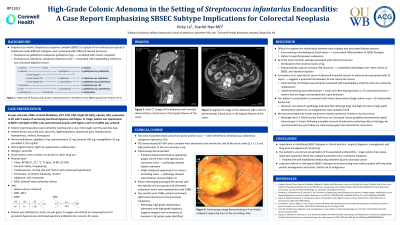Sunday Poster Session
Category: Infections and Microbiome
P1351 - High-Grade Colonic Adenoma in the Setting of Streptococcus Infantarius Endocarditis: A Case Report Emphasizing SBSEC Subtypes Implications for Colorectal Neoplasia
Sunday, October 26, 2025
3:30 PM - 7:00 PM PDT
Location: Exhibit Hall

Has Audio

Vicky Lu, BA
Oakland University William Beaumont School of Medicine
Arcadia, CA
Presenting Author(s)
Vicky Lu, BA1, Scarlett Hao, MD2
1Oakland University William Beaumont School of Medicine, Arcadia, CA; 2Corewell Health, Royal Oak, MI
Introduction: The Streptococcus bovis/ Streptococcus equinus complex (SBSEC) is a well-known cause of infectious endocarditis and has been associated with gastrointestinal malignancies. Among its subtypes, Streptococcus gallolyticus subspecies gallolyticus (Sg) is strongly linked to colonic neoplasia. In contrast, Streptococcus infantarius subspecies infantarius (Sii) is more commonly associated with hepatobiliary infections, and its role in colorectal cancer (CRC) is less clear. This case report highlights a rare presentation of Sii-associated endocarditis complicated by bacteremia and the discovery of a colonic mass. We emphasize the importance of distinguishing between SBSEC subtypes in clinical practice to better understand their long-term implications.
Case Description/Methods: 63-year-old male with a past medical history of obesity, hypertension, atrial fibrillation, deep venous thrombosis and chronic heart failure presented with two weeks of worsening dyspnea, hypotension and anemia. Imaging revealed bilateral pulmonary opacities and small pleural effusions. The patient was started on broad-spectrum antibiotics and vasopressors for suspected sepsis. Blood cultures grew Sii and echocardiogram revealed a 1.2 x 0.9 cm aortic valve vegetation with moderate to severe regurgitation. Abdominal CT demonstrated a 4.2 cm hepatic flexure mass and subsequent colonoscopy confirmed ascending colon adenomatous lesions. The patient underwent valve replacement. Two months later, he underwent a right hemicolectomy for presumed malignancy. Pathology revealed high-grade tubulovillous adenomas with negative margins.
Discussion: The evolving microbiological classification and inconsistent nomenclature of SBSEC subtypes presents challenges in exploring their disease processes. Historically, Sii has been primarily associated with hepatobiliary infection and non-colorectal malignancies. However in 2013, Corredoira et al. reported six cases of CRC in patients with Sii sepsis, suggesting a possible oncogenic role. While malignancy was not confirmed in our patient, the discovery of large high-grade adenomas supports the need for further investigation into potential association. Due to the unclear implications of the subtype, clinicians should consider early colonoscopy and close follow-up in patients with an SBSEC bacteremia, not just Sg. This case underscores the importance of subtype-specific microbial diagnostics in SBSEC bacteremia, which can hopefully guide appropriate cancer screening and long term surveillance.
Disclosures:
Vicky Lu, BA1, Scarlett Hao, MD2. P1351 - High-Grade Colonic Adenoma in the Setting of <i>Streptococcus Infantarius</i> Endocarditis: A Case Report Emphasizing SBSEC Subtypes Implications for Colorectal Neoplasia, ACG 2025 Annual Scientific Meeting Abstracts. Phoenix, AZ: American College of Gastroenterology.
1Oakland University William Beaumont School of Medicine, Arcadia, CA; 2Corewell Health, Royal Oak, MI
Introduction: The Streptococcus bovis/ Streptococcus equinus complex (SBSEC) is a well-known cause of infectious endocarditis and has been associated with gastrointestinal malignancies. Among its subtypes, Streptococcus gallolyticus subspecies gallolyticus (Sg) is strongly linked to colonic neoplasia. In contrast, Streptococcus infantarius subspecies infantarius (Sii) is more commonly associated with hepatobiliary infections, and its role in colorectal cancer (CRC) is less clear. This case report highlights a rare presentation of Sii-associated endocarditis complicated by bacteremia and the discovery of a colonic mass. We emphasize the importance of distinguishing between SBSEC subtypes in clinical practice to better understand their long-term implications.
Case Description/Methods: 63-year-old male with a past medical history of obesity, hypertension, atrial fibrillation, deep venous thrombosis and chronic heart failure presented with two weeks of worsening dyspnea, hypotension and anemia. Imaging revealed bilateral pulmonary opacities and small pleural effusions. The patient was started on broad-spectrum antibiotics and vasopressors for suspected sepsis. Blood cultures grew Sii and echocardiogram revealed a 1.2 x 0.9 cm aortic valve vegetation with moderate to severe regurgitation. Abdominal CT demonstrated a 4.2 cm hepatic flexure mass and subsequent colonoscopy confirmed ascending colon adenomatous lesions. The patient underwent valve replacement. Two months later, he underwent a right hemicolectomy for presumed malignancy. Pathology revealed high-grade tubulovillous adenomas with negative margins.
Discussion: The evolving microbiological classification and inconsistent nomenclature of SBSEC subtypes presents challenges in exploring their disease processes. Historically, Sii has been primarily associated with hepatobiliary infection and non-colorectal malignancies. However in 2013, Corredoira et al. reported six cases of CRC in patients with Sii sepsis, suggesting a possible oncogenic role. While malignancy was not confirmed in our patient, the discovery of large high-grade adenomas supports the need for further investigation into potential association. Due to the unclear implications of the subtype, clinicians should consider early colonoscopy and close follow-up in patients with an SBSEC bacteremia, not just Sg. This case underscores the importance of subtype-specific microbial diagnostics in SBSEC bacteremia, which can hopefully guide appropriate cancer screening and long term surveillance.
Disclosures:
Vicky Lu indicated no relevant financial relationships.
Scarlett Hao indicated no relevant financial relationships.
Vicky Lu, BA1, Scarlett Hao, MD2. P1351 - High-Grade Colonic Adenoma in the Setting of <i>Streptococcus Infantarius</i> Endocarditis: A Case Report Emphasizing SBSEC Subtypes Implications for Colorectal Neoplasia, ACG 2025 Annual Scientific Meeting Abstracts. Phoenix, AZ: American College of Gastroenterology.
